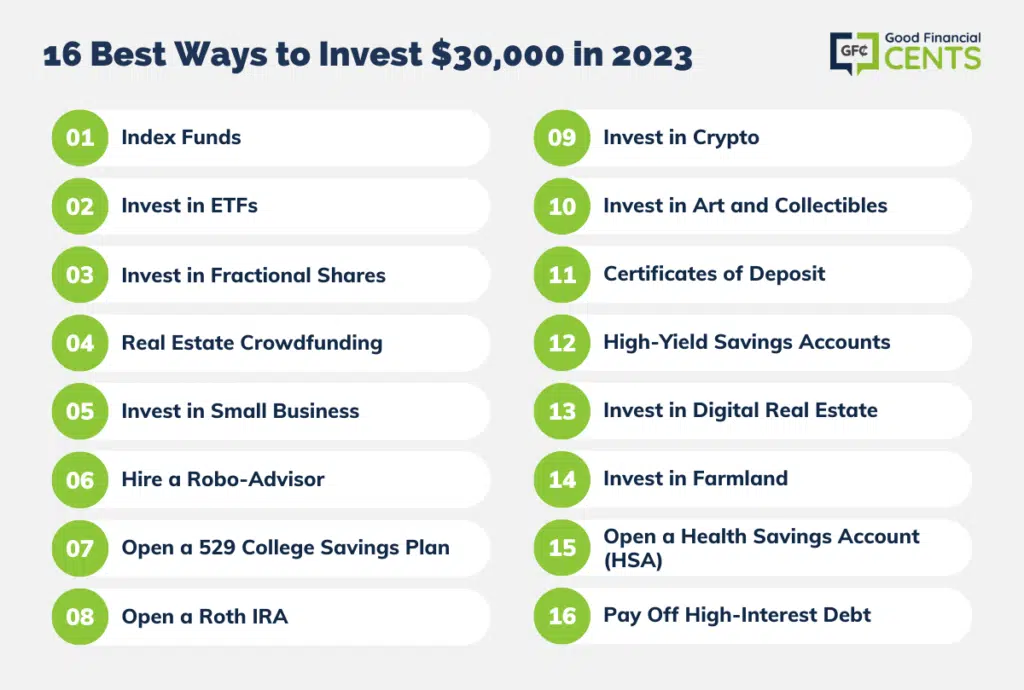Do you have $30,000 burning a hole in your pocket? You’ll be rewarded if you can invest it for the long haul. As this compound interest calculator demonstrates, investing $30,000 at a return of 8% for 20 years will leave you with $138,828. If you can secure a return of 10% over that time, you’ll end the 20 years with $201,825.
But where should you invest your $30,000? There are many options, but your top priority should be choosing an investment that aligns well with your goals and risk tolerance.
With that in mind, I wanted to review some of my top suggestions for investing $30,000 in 2025. Most of these options are passive in nature, and remember that you can spread your initial investment across more than one option if you prefer.
16 Best Ways to Invest $30,000 in 2025
1. Index Funds
2. Invest in ETFs
3. Invest in Fractional Shares
4. Real Estate Crowdfunding
5. Invest in Small Business
6. Hire a Robo-Advisor
7. Open a 529 College Savings Plan
8. Open a Roth IRA
9. Invest in Crypto
10. Invest in Art and Collectibles
11. Certificates of Deposit
12. High-Yield Savings Accounts
13. Invest in Digital Real Estate
14. Invest in Farmland
15. Open a Health Savings Account (HSA)
16. Pay Off High-Interest Debt
1. Index Funds
Index funds have become popular among the FIRE (financial independence, retire early) crowd, and for a good reason. These funds track an index like the S&P 500, which means you can grow wealth based on the long-term growth of the markets. Your investment into index funds is also entirely passive, meaning you can open a brokerage account, invest your $30,000, and leave it to grow and compound over time.
You are bound to lose money during some years, then turn around and have significant gains during other years. This is the essence of how the stock market works, so it’s no surprise that tracking an index is no different.
For example, the S&P 500 ended 2022 down by quite a bit. Here’s how this index performed in previous years:
- 2023: 24.20%
- 2022: -19.44%
- 2021: 26.89%
- 2020: 16.26%
- 2019: 28.88%
- 2018: – 6.24%
- 2017: 19.42%
- 2016: 9.54%
- 2015: -0.73%
- 2014: 11.39%
- 2013: 29.60%
- 2012: 13.41%
If you decide to invest in index funds, you can open a brokerage account with various platforms, like Vanguard or Fidelity, or even with popular investment apps like Robinhood.
2. Invest in ETFs
The cheapest way to buy the index might be to invest in exchange-traded funds (ETFs). Like index mutual funds, ETFs are built to match the returns of an underlying index, and they often have lower fees or expense ratios (MERs).
For example, Vanguard’s 500 Index Fund Admiral Shares (VFIAX) charges an MER of only 0.04%, and the Vanguard S&P 500 ETF MER is even lower, at 0.03%.
Like stocks, ETFs can also be bought and sold during the trading day, and you can often get started investing with just a few dollars. If you decide to start investing in ETFs, there are quite a few platforms to consider, including Betterment, M1 Finance, and TD Ameritrade.
3. Invest in Fractional Shares (M1 Finance)
One of the challenges of building a diversified portfolio with individual stocks is that some come with a high sticker price of $2,000 per share, $5,000 per share, or more. Maybe you want another way to diversify your $30,000 investment across a broad range of stocks and other investments. Platforms like M1 Finance help by allowing you to buy fractional shares.
Investing in fractional shares works exactly as it sounds. Essentially, they let you buy a fraction of a stock versus buying a total share or multiple shares each time you invest. This investing strategy works especially well with high-priced stocks.
M1 Finance has a unique approach that lets you invest in “pies” of stocks and ETFs, including fractional shares.
With M1 Finance, you can invest without fees, and opening an account is a breeze. Read my M1 Finance review to learn more about how this investing app works.
4. Real Estate Crowdfunding

You can invest $30,000 in real estate, but you don’t have to do it the old-fashioned way. Instead of shopping for a rental property and doing all the heavy lifting of a landlord, you can earn passive income through real estate investment trusts (REITs).
Fundrise is an excellent choice for real estate investing. While you can start with Fundrise with a minimum investment of $10, you’ll have more customization options if you start with their Core plan, which requires at least $5,000 to get started. Note that Fundrise requires a 0.15% annual advisory fee and an annual asset management fee of up to 0.85%.
Read my Fundrise review to learn more, and check out my personal four-year returns with the platform.
| I’ve been investing with Fundrise since 2018. Disclosure: when you sign up with my link, I earn a commission. All opinions are my own. |
In the meantime, you can also check out a real estate crowdfunding platform called RealtyMogul. This platform works similarly since it lets you invest in real estate on a passive basis. However, RealtyMogul is only for accredited investors. Check out my RealtyMogul review to learn more.
5. Invest in a Small Business
Investing in small businesses can be a great way to diversify beyond the stock market. You’ll need a few good ideas to develop a business plan that could work. You could start a home-based business or consider investing in a franchise.
Another strategy involves investing in a platform called Mainvest, which lets you passively move funds into small businesses. With Mainvest, you can begin investing with as little as $100 – to date, many investors have received targeted returns of 10% to 25%.
Other Mainvest benefits include low fees and diversifying your funds across different industry sectors. Mainvest has invested its funds in everything from family-owned restaurants to breweries and cannabis cultivation centers.
6. Hire a Robo-Advisor
Did you know? You no longer have to hire a financial advisor to help you to invest your money. You can invest with the help of a robo-advisor. A robo-advisor uses AI technology to gather your information and recommend a suitable investment portfolio aligned to your investment objectives and risk tolerance, all without the involvement of a human advisor.
One of my favorite robo-advisors is Betterment. Betterment lets you open an account with a $0 minimum balance. From there, you’ll pay a 0.25% annual investing fee to access multiple portfolio options, advanced tax-saving tools, automatic portfolio rebalancing, and other perks.
Betterment also helps you determine where to invest your money based on your short-term and long-term goals and risk tolerance. If you think a robo-advisor could work for you and like getting help choosing your investments, read my Betterment review.
7. Open a 529 College Savings Plan
Do you have kids approaching college age? In that case, you might consider stashing away part of your $30,000 nest egg for their future. This strategy works best when you already have a solid plan for your retirement and your other financial ducks are in a row.
Either way, you can open a 529 savings plan with your state or another state that offers your preferred program. While not always the case, some states even offer tax breaks for contributing to a 529 plan. In Indiana, for example, families can contribute $7,500 to a 529 plan in 2025 and get a 20% tax credit from the state or up to $1,500 back at tax time. A $5,000 contribution would equate to $1,000 when you file your tax return.
8. Open a Roth IRA
If you meet certain income requirements and want to build up tax-free income for retirement, you should also consider contributing to a Roth IRA. The tax-sheltered retirement account lets you contribute after-tax money, and you won’t have to pay income taxes on withdrawals once you reach retirement age (59 ½).
The best part about investing in a Roth IRA is the fact you get to pick the underlying investments for your account. For example, you can use your Roth IRA to invest in individual stocks, bonds, mutual funds, ETFs, etc.
You can open a Roth IRA using several platforms, including M1 Finance, Stash, TD Ameritrade, and Betterment.
Remember:
9. Invest in Crypto
Investing in cryptocurrency probably feels pretty perilous right now. Not only did crypto markets sustain billions in losses throughout 2022, but several major crypto platforms filed for bankruptcy. This includes a few platforms I’ve used to invest in crypto myself, Celsius and BlockFi.
That said, now may be a good time to invest in cryptocurrencies you believe might outlast the rest. For the most part, that probably means investing in Bitcoin or Ethereum. If you do decide to invest, remember that any crypto investment is highly speculative in nature and to expect high levels of volatility.
Keep a long-term mindset and never invest money you can’t afford to lose.
If you’re wondering which crypto platforms remain, check out my guide to the best crypto exchanges available.
10. Invest in Art and Collectibles

Masterworks is a crowdfunding platform that lets regular people invest in multi-million dollar works of art. It accomplishes this by securitizing the artwork, allowing large groups of individual investors to purchase shares for fractional ownership.
According to Masterworks, art and collectibles have seen massive appreciation over the last 25+ years, even beating out the S&P 500 and gold. Even better, the experts behind the platform select the art they believe will see the best appreciation, and they hold each piece for three to 10 years to sell for a profit.
This being said Masterworks doesn’t let just anyone open an account. You have to request an invitation to see if you’re eligible, at which point you can fund an account and start investing.
Also, be aware that Masterworks charges a 1.5% annual management fee, which is higher than the fees you’ll pay with most other investments I recommend. Learn more in our Masterworks review.
11. Certificates of Deposit
While investing in “safe” options like certificates of deposit (CDs) hasn’t returned much in the way of yield in the last few years, rising interest rates are changing all of that. You can now find CDs with yields over 5%. Better yet, your funds are FDIC-insured in amounts up to $250,000 per deposit per account.
Save Better is one of the best platforms to use if you want to lock in a CD with the highest possible yield. The Save Better website is just a savings account and CD comparison platform, meaning you can use it to compare savings products across a range of online banks.
While Save Better CDs let you invest small amounts of money, even as little as $1, you could easily put your entire $30,000 nest egg in a CD if the safety of the principal is your priority.
12. High-Yield Savings Accounts
You can also consider putting all or part of your $30,000 in a high-yield savings account. Like CDs, online savings accounts are bringing in much better returns than they have for the last few years.
How much can you earn on your money in a high-yield savings account? Currently, Save Better will let you earn 5.26% APY on your savings with no account fees and minimum balance requirements.

5.26%
Interest Rate
varies
Min. Initial Deposit
While you could potentially secure a higher return in the stock market, high-yield savings accounts offer a “safe place” to keep your cash until you need it. Like certificates of deposit (CDs), these accounts are FDIC-insured in amounts up to $250,000 per deposit per account.
13. Invest in Digital Real Estate
Another option to consider for your $30,000 involves investing in digital real estate. But what is digital real estate exactly?
This asset class comes in many forms, including the website you’re reading. Other types of digital real estate you can invest in include:
- Domain names you buy and sell for profit
- Affiliate websites that earn passive income
- Assets and land sold in the metaverse
- Authority websites in a specific niche
- Digital products like courses and printables
- Email lists you can sell to others
- YouTube channel
- Paid membership groups
- YouTube channels
- Social media channels
It’s possible to invest in digital real estate that is already turning a profit, yet you have an even higher potential for profits if you build your own platform or website from the ground up.
For example, my digital real estate portfolio includes this website – GoodFinancialCents.com – my YouTube channel, and several online courses I own. These are all assets I built from scratch, and I have used them to earn millions of dollars over the years.
If you’re curious about how to get started earning with digital real estate, you should check out my Make 1k Blogging course, which is free.
Also, read over the following blog posts for more ideas:
14. Invest in Farmland

Maybe you want to be like Bill Gates and start snatching up all the available farmland in your area. You can certainly do that, but there’s a much more affordable way to invest in farmland.
A platform called FarmTogether makes this option possible by letting investors put their money into fractional shares of farmland all over the country. When you invest with FarmTogether, your funds may be invested in anything from pecan orchards to organic vineyards or land used to grow soybeans or corn.
The platform targets net returns of 6% to 13% per year with a 2% to 9% targeted net cash yield. In the meantime, FarmTogether claims to have brought investors 11% in total annual returns from 1992 to 2021.
However, it’s worth noting that FarmTogether is only available to accredited investors.
15. Open a Health Savings Account (HSA)
If you have a high deductible health insurance plan (HDHP) and want to set aside funds for future healthcare costs, opening a health savings account (HSA) is an excellent idea. This type of account comes with an upfront tax break in the year you contribute. Plus, the funds in your HSA can grow tax-free, and you won’t pay taxes on withdrawals when you use the money for eligible healthcare expenses.
Requirements to open and use an HSA in 2025 are fairly straightforward. Generally speaking, these accounts are available to individuals with a minimum health insurance deductible of $1,600 or families with a minimum deductible of $3,200. In the meantime, health insurance plans must have an out-of-pocket maximum of $8,050 or below for individuals or $16,100 or below for families.
Eligible individuals can contribute up to $4,150 in 2025 to an HSA from there, and families can contribute up to $8,300. The only exception applies to those aged 50 and older, who can contribute an additional $1,000 yearly in what is known as a “catch-up” contribution.
If you believe you’re eligible for an HSA, consider opening an account with Lively. Not only does Lively let you invest your underlying HSA funds into the stock market, but this account doesn’t have any account management fees or hidden fees.
16. Pay Off High-Interest Debt
While this final option isn’t necessarily an investment, it may be the best place to allocate part or all of your $30,000, depending on your situation. If you have high-interest debt, such as credit card or personal loan debt, you can save a ton of interest over time by paying it off.
This same rule can even apply if you have a car loan with a high interest rate or if the mortgage on your home has a higher interest rate than you expect to earn with other investments over the next few years.
Paying off debt can be especially important right now while rates are high. For example, LendingTree reports that the average credit card interest rate is 24.45%. If you take all or part of your $30,000 and pay off debt at that rate, the money you save in interest will be more than any return you could by investing over the same period.

Final Thoughts on How to Invest 30K
As you look over all the potential ways you can invest $30,000 in this guide, it’s easy to feel overwhelmed. Consider the following advice to find the right investments for your lifestyle and goals.
1. Consider your investing timeline. Before investing $30,000, you should consider when you’ll need the funds. If you believe you’ll need the money in the next few years, you may want to stick with FDIC-insured safer investments. If you’re investing for retirement, on the other hand, one of the riskier options could give you more potential for long-term growth.
2. Assess your risk tolerance. Also, consider how much risk you’re willing to take on, and remember that many of the investment options in this guide can lose money in the short term.
3. Keep fees in mind. Research shows time and time again that investing fees have a dramatic impact on your returns over time. A study from the Securities and Exchange Commission (SEC) shows that, on a $100,000 portfolio, paying 1.0% in annual fees reduces returns by $30,000 over 20 years compared to a portfolio with a 0.25% annual fee.
4. Don’t overthink it. With all this being said, don’t get so overwhelmed by options and research that you never invest your $30,000. “Analysis paralysis” can also cost you money over the long run, so pick a few options you feel good about and invest immediately.









